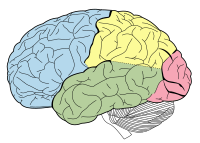
Photo from wikipedia
HighlightsEmpirical studies associate apathy in various disorders with deficits in the lateral parietal cortex.Current understanding of the mechanisms underlying symptoms of apathy does not explain this association.Internally‐driven action initiation, intention,… Click to show full abstract
HighlightsEmpirical studies associate apathy in various disorders with deficits in the lateral parietal cortex.Current understanding of the mechanisms underlying symptoms of apathy does not explain this association.Internally‐driven action initiation, intention, and sense of agency are ascribed to the inferior parietal lobuleGoal‐directed behavior engages the inferior parietal lobule through volition (selecting action effectors, intention, and sense of agency)Impairment in mechanisms of internally‐driven actions may underlie the association between the inferior parietal lobule and apathy. Abstract A reduction in goal‐directed behavior, or apathy, occurs in neurological and psychiatric disorders, though its neural substrates remain unclear. Deficits in circuits connecting the prefrontal cortex to subcortical regions are considered to underlie apathy. Although apathy is empirically associated with widespread changes in these regions, studies across disorders also link apathy with the lateral parietal cortex. Such variety in regional involvement is consistent with the established role of prefrontal and subcortical regions in models of goal‐directed behavior, and with the suggestion of subtypes of apathy. However, these models do not provide a basis for the involvement of the lateral parietal cortex with apathy. Here, we review the association between lateral parietal cortex dysfunction and apathy across disorders and analyze the putative cognitive functions that may link this region with goal‐directed behavior. We suggest that neural processes in the angular and supramarginal gyri of the inferior parietal lobule may provide an interface enabling the transformation of internal goals to external actions through intentional initiation of action interrelated with mechanisms of primary sensorimotor transformation. Consequently, we propose that impairment in this process of embedding intended action in a ‘body schema’ facilitating adequate recruitment of an effector system, is the likely mechanism underlying the association between the lateral parietal cortex and apathy. Considering the evidence, we propose a revised neurocognitive model of apathy where deficient internal initiation of behavior mediated by the inferior parietal lobule may be sufficient, though not necessary, to reduce goal‐directed behavior, and may constitute a volitional subtype of apathy.
Journal Title: Progress in Neurobiology
Year Published: 2018
Link to full text (if available)
Share on Social Media: Sign Up to like & get
recommendations!